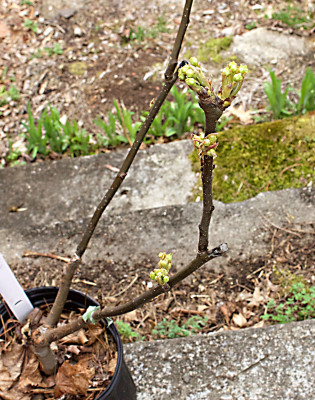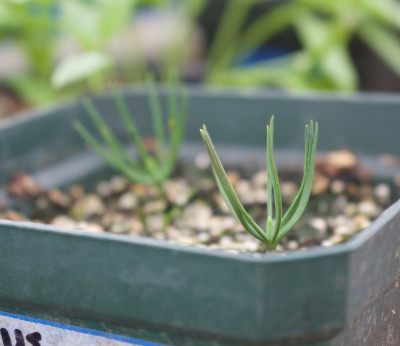HISTORIC PEAR AND NUTTY PINE
M’Lady’s Luscious Pear
Gardening provides so many avenues of interest down which to wander. The broad avenue of history, for example, which comes to mind as I checked up on the Lady Petre pear I made.
This pear’s most recent history traces back to last year when, after doing a grafting workshop with the Philadelphia Orchard Project at historic Bartram’s Garden in Philadelphia, I was offered a sprig from the Lady Petre pear tree there. I grow about two dozen varieties of pear, so the last thing I needed was another pear tree. But Lady Petre was special.
John Bartram is often considered “America’s first botanist.” In addition to collecting plants and sharing them with others, mostly in England, he sometimes received plants. Such as the pear seed from England’s Lady Petre, in 1735.
Quoting from the account published in John Loudon’s The Gardener’s Magazine of 1831, the seed was “planted by Mr. Bartram near one end of the dwelling-house, at the edge of a gravel walk, where It has never received any manure or rich earth . . . The tree has never been subject to blight, and has not once failed to bear In the last thirty years; some seasons producing 10 to 12 bushels of fine handsome fruit, which Is in good eating from the middle of September to Christmas. The fruit is always worth from three dollars to five dollars a bushel . . . It Is in the most perfect health, although near a century old.”
Almost a hundred years after that, Ulysses P. Hedrick wrote, in his 1921 tome, The Pears of New York, that “the tree still stands, somewhat stricken with its two centuries, but withal a noble specimen seemingly capable of breasting large blows of age for many years to come.” Alas, the Lady Petre tree finally succumbed to old age in the latter half of the 20th century — but not before someone had the foresight to clip of some branches to graft and make new trees.
As far as the fruit, Mr. Bartram wrote that “The Pear raised from her (Lady Petre’s) seed hath borne a number of the finest relished fruit. I think a better is not in the world.” More specifically, the fruit was described as having flesh that is “white, soft, juicy, melting, like a butter pear; delicious flavour, peculiar, very slightly musky, and vinous.”

Flowers already forming on young grafted tree
And now I have a clone of that original plant and can look forward to tasting the fruit, the first variety of pear to have originated in America. The stated resistance to blight is a plus because blight — fireblight — is still a problem in pear orchards. (And fireblight has its own history: First noted in Highland Falls, NY, and the first recognized bacterial disease of plants.)
Mr. Bartram did state that “the tree was about twenty years old before It produced fruit, and narrowly escaped being cut down as barren.” Pear and apple trees grown from seed will often take 10 or 20 years before bearing fruit — and then the fruits they bear, more often than not, aren’t worth eating. Grafted trees bear sooner, and especially those grafted on dwarfing rootstocks. I made my Lady Petre pear tree by grafting the sprig I got onto a dwarfing rootstock so I’m hoping to be able to report back on the fruit within 5 years.
Not One, But Two, Grafts
My Lady Petre tree is special because not only is it the variety Lady Petre, and not only is it grafted on a dwarfing rootstock, but also because it’s an “interstem tree.”
Dwarfing rootstocks having the advantages of making trees that can be pruned and picked with feet on the ground. Not as obvious is their yielding more fruit per square foot of land because they harvest sunlight so efficiently. They also tend to bear at a younger age.
Many dwarfing rootstocks have restricted or brittle root systems. As a result, dwarf trees generally need first-class soil conditions as well as staking throughout their lifespans, which usually are shorter than full-size trees.
My interstem tree began life as a seedling I grew from a pear seed. Seedling trees are full-size and slow to begin bearing, but have resilient and sturdy roots. A few inches above ground level, I grafted a foot-long stem from a dwarfing rootstock. Atop that dwarfing interstem went the sprig of Lady Petre I had brought home from Philadelphia. That foot-long piece of stem from a dwarfing rootstock is all that’s needed to graft whatever goes above it.
Pears graft easily, so I was able to do both grafts at the same time last year, and have them take.
Many Pines are Nutty
Wandering down a different avenue, gardening can lead us into the future, or, at least, a vision of the future. Embodied, for example, in the 4 inch pot of soil sitting on my greenhouse bench. Poking up out of the soil are two small twigs. And I do mean small, each an inch or so high. Capping each is a small whorl of green needles.

Limber pine seedlings
These two twiggy thingies are limber pine (Pinus flexilis) trees that I’m growing from seed. The common and botanical name relate to the plants flexibility; branches can be tied into knots. Looking into the future, these seedlings could grow to 60 feet in height and under good conditions — which would be drier, mountainous regions of western North America — could live over 1,000 years!
I’m growing limber pine for its seeds: pine nuts. All pines’ nuts are edible but only those with large nuts are worth bothering with. This one’s can be 1/3 by 1/2 inches large, although it will be many years before I’ll get to gather these tasty morsels from the two plants.
I’m guessing limber twig pine nuts and Lady Petre pears, both ready for harvest in early fall, will be a tasty combination.


Lee, when the Lady Petre pear tree is older and needs pruning I hope you pass around the scions! I am starting an orchard in Maryland and would love to have a scion or two someday. Please keep me in mind. Cheers, Steve
I’ll keep everyone posted about Lady Petre.
Never heard of interstem grafting. What is your preferred dwarfing rootstock for Euro and Asian pears? Would Bartlett seedlings be good rootstock? Your blog is awesome. Thanks for all the hard work you put into it!
My preferred rootstock for pears is still to be determined. Generally, I’ve been using OH X F 87 or OH X F 333. A new rootstock P233 is super-dwarfing and precocious. I’ve only had it a short while, though. You have to be careful with precocious rootstocks for Asian pears. They are naturally precocious, so are apt to runt out, just fruiting and hardly growing, if not managed carefully on dwarfing rootstocks.
Just heard your interview on grafting on You Bet Your Garden (the interview you taped before going to the prison to teach grafting).
You mentioned that rooting apple cuttings is hard.
You mentioned that cloning root stock is difficult, but there are methods.
I like challenges. What book do you describe how to do this?
I want to try to root apple cuttings just for the challenge. I don’t mind if a standard tree grows because I don’t own property yet and it will get cut down anyway.
I currently own the pruning book and grow fruit naturally.
Are there grafting bibles that you recommend?
The grafting bible is “The Grafters Handbook” by Garner. For all things about propagating, “Plant Propagation” by Hartman and Kester.
The only method I’ve ever read of that’s successful for rooting apple cuttings involves growing part of a shoot in the dark for awhile before taking the cutting. Google something like “stock plant etiolation rooting.” A good reference is http://www.hort.cornell.edu/uhi/research/articles/IntPlantProp35.pdf. I read about this many years ago but never tried it.
Hi, I just planted three limber pines in my backyard in St. Louis, MO. They are about 8′ tall. I was told they are slow growers putting on about a foot a year, but was also told they would possibly get 20′ at maturity. Can they really get 70′? Also how can I harvest the pine nuts. We currently have candles about 6-7″ long. When would you recommend pruning them? Or should we? Thank you for such an interesting and informative blog.
Yes, they can get that tall — eventually, depending on growing conditions and climate. My guess is that you either knock cones down or wait for them to drop, hopefully with nuts still within. Any pruning will slow growth and maturity, so I would avoid pruning unless for aesthetic reasons.
I had heard of trimming the candles, leaving about 2″ still on the tree, in order to encourage the tree to become fuller/bushier. I would like our trees to fill out more, but I also want them to grow taller. Also, I should tell you we put them in this spring balled and burlapped. We are on pins and needles, as evergreens make us nervous (there are so many brown ones), so we are trying to do everything right! Since they have a compromised root ball from being B&B, would trimming the candles to slow the growth help the tree to put more energy into establishing a better root system? Other than fertilizing with acid fertilizer and providing good drainage, any other tips for evergreens? Thanks so much.
Right, leave the candles alone this year. Stem tips actually help root growth. Most important in getting the plants established is, besides good drainage at the site, watering as needed (but not overwatering).
Pinus Flexius Nut Production does not begin until the plants age ranges from 20 to 40 years. Additionally there are 2 to 4 years between large seed crops.
Good Luck.
Hmmm. I might have to think again about nurturing these seedlings to nut-hood. I’m patient but perhaps not that much.